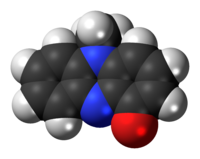Pyocyanin
 |
|
 |
|
| Names | |
|---|---|
|
IUPAC name
5-Methylphenazin-1-one
|
|
| Other names
Pyocyanin; Pyrocyanine; 5-Methyl-1(5H)-phenazinone; Sanasin; Sanazin
|
|
| Identifiers | |
|
3D model (Jmol)
|
|
| ChemSpider | |
| ECHA InfoCard | 100.213.248 |
| MeSH | D011710 |
|
PubChem CID
|
|
|
|
|
|
| Properties | |
| C13H10N2O | |
| Molar mass | 210.24 g·mol−1 |
| Appearance | Solid |
|
Except where otherwise noted, data are given for materials in their standard state (at 25 °C [77 °F], 100 kPa).
|
|
|
|
|
| Infobox references | |
Pyocyanin (PCN−) is one of the many toxins produced and secreted by the Gram negative bacterium Pseudomonas aeruginosa. Pyocyanin is a blue, secondary metabolite with the ability to oxidise and reduce other molecules and therefore can kill microbes competing against P. aeruginosa as well as mammalian cells of the lungs which P. aeruginosa has infected during cystic fibrosis. Since pyocyanin is a zwitterion at blood pH, it is easily able to cross the cell membrane. There are three different states in which pyocyanin can exist; oxidized, monovalently reduced or divalently reduced. Mitochondria play a huge role in the cycling of pyocyanin between its redox states. Due to its redox-active properties, pyocyanin generates reactive oxygen species.
In order for pyocyanin to be synthesized by P. aeruginosa, two specific genes must be functional. MvfR is a gene which produces a transcription factor which activates phnAB genes. These genes produce the molecule quinolone which then regulates operons 1 and 2 of phzRABCDEFG which are key to the synthesis of phenazine. The synthesis of pyocyanin is primarily controlled by the quorum sensing process. P.aeruginosa strains which are unable to synthesise PCN can still benefit from its effects if the strain has co- infected the lung with wild type strains which can produce pyocyanin. Biosynthesis can be impaired by disrupting the aro pathway which is responsible for the synthesis of chorismic acid from shikimate. Chorismic acid is the precursor of pyocyanin.
The complete virulence of P. aeruginosa can only be experienced when pyocyanin is produced.
Pyocyanin inactivates catalase by reducing its gene’s transcription as well as directly targeting the enzyme itself. Glutathione is an important antioxidant modulated by pyocyanin. In particular the pool of the reduced form is depleted while the oxidised form is promoted by hydrogen peroxide which is not dismutated by catalase. In the cystic fibrosis lung, intracellular pyocyanin converts molecular oxygen to the superoxide free radical by oxidizing NADPH to NADP+. This has a doubly negative effect on the lungs. Firstly, the NADPH used by pyocyanin depletes the available substrate for the reaction catalysed by the NADPH oxidase enzyme. Secondly, the superoxide radical generated can inhibit cytokines such as IL-4, IL-13 and IFN-γ which usually upregulate NADPH oxidase. When the lung is confronted with pyocyanin, an increased concentration of catalase and superoxide dismutase is seen in order to deal with the barrage of radicals being produced.
...
Wikipedia
